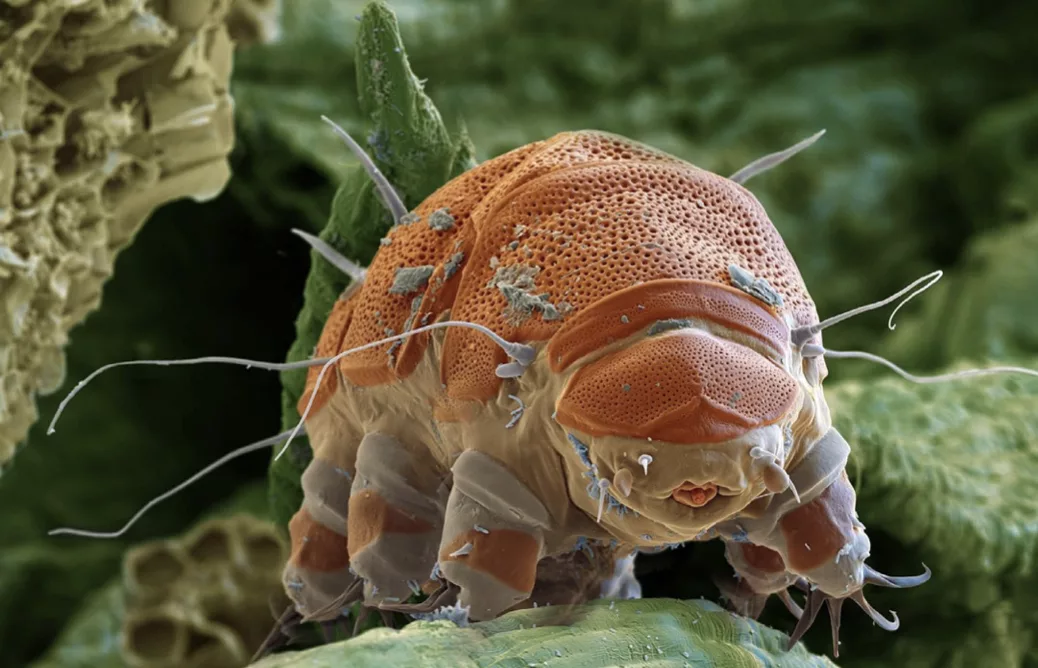
By Jim Knox
I first learned about Water Bears from my eighth grade biology teacher, Mr. Emrich. A kind man and exceptional educator rivaling any of my professors, he alerted our eighth grade minds to the breadth of the living world, with all of its less charismatic and well known inhabitants. Like most of my classmates, I was intrigued by the name, Water Bear.
Conjuring images of aquatic mammals, Water Bears (aka Moss Piglets) are neither mammalian, nor entirely aquatic. Although known for their preference for aquatic environments (either freshwater or saltwater), they abound in forest, tundra and even desert habitats worldwide. These tiny creatures, properly known as tardigrades, top out at 1 millimeter in length–the width of a pencil line, and represent a diverse group. To date, more than 1,200 species have been documented in their phylum, with each one more astounding than the last.
Discovered in 1773 by biologist, Johann Goeze, these micro beasts do indeed resemble the basic form of a bear. With robust, eight- legged, segmented bodies and claws on the ends of their legs, these plump, oddly cute little creatures roam their world searching for organic matter on which to feed. Extending their telescoping mouthparts outward, they latch onto food with sharp stylets (toothlike structures) to suck juices from moss, algae and lichens. While the vast majority of Water Bears are herbivores, some are opportunistic omnivores, like their namesake. Adopting a very bruin-like strategy, a select few are downright carnivores–even resorting to cannibalism.
To say tardigrades are survivors would be like saying Michael Jordan is a decent basketball player. The more we study them, the more we learn about tardigrade biology and physiology, and it is quite impressive. Called, “The World’s Toughest Creatures” by microbiologists and “Virtually Indestructible” by legions of other scientists, they have earned these titles with each eight-legged step of their journey. And this journey is quite some trek through time. Tardigrades have been swimming, crawling and lumbering through our planet’s micro habitats for the past 600 million years. The dinosaurs, by contrast, came on the scene a mere 230 million years ago.
For species to survive for six million years is significant. For them to survive 600 million years puts them in another echelon altogether. You don’t get to the animal kingdom’s hall of fame by accident. Tardigrades outlast the competition through employing astounding physical and behavioral adaptations which define them as extremophiles or extreme organisms. They’re among the first life forms to pioneer lava fields, they frequently swim within scalding geothermal hot springs, and they are the only species known to survive in outer space! Even among extremophiles, they sit at the top of the heap.
When drought or extreme cold hits, they pull their legs in, retract their heads, retreat into a ball-like capsule known as a tun, and secrete a protective, anti-desiccant coating. In this form, tardigrades also secrete a sugary gel known as Trehalose to protect their vital organs and reduce their metabolic functions one hundred fold. In this death- likestateknownascryptobiosis, tardigrades can survive in suspendedanimationforatleast 30 years. Amazingly, they even produce a protein to protect their DNA from exposure to radiation!
Impervious to lethal conditions for nearly all other organisms, their physiological traits read like those of a graphic novel superhero. Tardigrades can withstand: temperatures of 303 degrees Fahrenheit, atmospheric pressure six times greater than that at the bottom of the Mariana Trench, freezing solid at -458 degrees Fahrenheit, living in the vacuum of outer space for 10 days, and bombardment by cosmic radiation…and I thought Superman was impressive…
Their seeming invincibility even carries over into their reproductive strategies. Tardigrades reproduce sexually–with females laying eggs and males fertilizing them–until they don’t. That is to say, when males are scarce or absent, females reproduce asexually. Through a process known as parthenogenesis, they lay eggs which hatch without fertilization. Either type of reproduction yields up to 30 Water Bear offspring per female.
Their nearly incomprehensible abilities astound us, yet Water Bears are more than a superbly adapted organism. They serve as models for both inspiration and replication. Water Bears have survived unscathed through the five greatest extinction events the planet has known. They have so much they can teach us. We have an opportunity to study them, learn from them, and apply those lessons.
As we contend with the daunting natural challenges of the 21st century, I find myself wishing for a “tech” hidden in nature that holds the promise of addressing–and even solving– some of these seemingly unassailable problems. If only there was a species which held the answers to: surviving extreme heat and cold, enduring decade-long droughts and colonizing new habitats. Enter the Water Bear–nature’s “super tech”. Our planet’s biggest, boldest and fiercest have adorned our flags, coats of arms, and family crests for centuries. Yet there is one minuscule beast which does what all others cannot. It may be that the answers to the colossal issues of the present, reside in the tiniest of creatures from the past.
Jim Knox is Curator of Education at Connecticut’s Beardsley Zoo where he directs education and conservation initiatives to advance the protection of wildlife in Connecticut and beyond.


